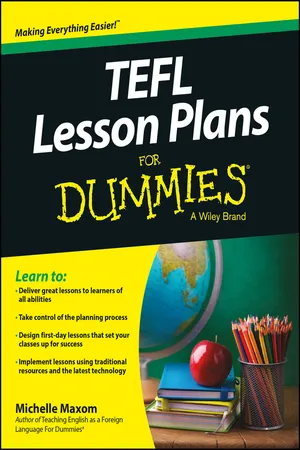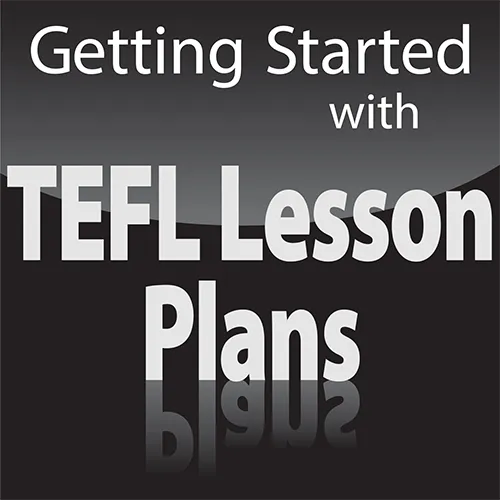
TEFL Lesson Plans For Dummies
Michelle M. Maxom
- English
- ePUB (disponibile sull'app)
- Disponibile su iOS e Android
TEFL Lesson Plans For Dummies
Michelle M. Maxom
Informazioni sul libro
Instant English lessons – learn in a flash!
TEFL Lesson Plans For Dummies is a ready-made course manual for TEFL teachers. With fully fleshed-out lessons, activities, tools, games, and resources, this book contains what is essentially an instant TEFL course. Use the ready-made materials directly in the classroom, or follow along with the detailed planning models and frameworks to grow your skills while designing your own lesson plans more effectively. The book includes access to online materials you can print for use in class, and the lessons can be used with or without the aid of technology in the classroom. You'll find expert advice on teaching all age levels and class sizes, including ideas for taking the lessons out into the world.
Many EFL/ESL teachers have little or no experience, and may have only been in the profession for a limited time. TEFL Lesson Plans For Dummies saves the day with materials, ideas, and activities that can be implemented quickly and easily, making lessons more productive and fun. From quick exercises to larger-scale plans, this book contains hundreds of ways to help your students become more proficient English speakers.
- Implement expertly-designed planning models with step-by-step advice
- Teach lessons designed for students of all ages and classes of all sizes
- Integrate technology when it's available, or do without it when it's not
- Move your lessons outside of the classroom for deeper immersion
Whether you're taking a TEFL training course, about to head out on your first job, or a veteran of the field, this book provides you with the tools you will need to get things moving in class. If you're looking to cut down on planning time without sacrificing student engagement, TEFL Lesson Plans For Dummies is the classroom-ready resource you need.
Domande frequenti
Informazioni
Methodology in the Madness

- Come to grips with the nitty-gritty of TEFL teaching, including an overview of what we’ve learned about English teaching down the years.
- Find out how to adapt recent advances and theories in TEFL to your work.
- Get the right fit between your lessons and the syllabus.
- Work out the anatomy of a great lesson plan.
- Put together a TEFL toolbox of worksheets, props and board activities.
Grasping The Basics Of TEFL Teaching




Understanding TEFL Language Terminology
Verbs and tenses

Nouns and pronouns


- Florence needs water and Florence gets the water from the kitchen.
- Florence needs water and she gets it from the kitchen.
Subjects and objects
- Florence needs water.
- I went to the shop.
- Reading books is fun.
- I love it.
- She reads a book.
- They waved to the boys.
Prepositions
- You should walk through the park.
- Mike lives with Jenna.
Adjectives
Adverbs
Qualifiers
- That meal was rather nice.
- Gold is quite expensive.
Articles
Conjunctions
Recognising the Different Types of English Course
- Academic English: For students who want to undertake a course of higher education in the English language. On a course of this nature students learn how to express concepts, ideas, and theories using formal, impersonal language. Students also practise essay writing, giving formal presentations, listening, and note-taking for lectures.
- Business English: Tends to cover the same grammatical structures as general English. However, the context for using the language is always a business meeting, a negotiation, a formal letter, or another function of day-to-day business life. These courses may be sponsored by a company for its employees.
- English for Speakers of Other Languages (ESOL): For students who are now living in an English-speaking country where they want to settle. Practical skills such as speaking to employees at government offices and banks or visiting healthcare professionals are included in the course material.
- English for Specific Purposes (ESP): A branch of teaching whereby you analyse exactly what the student needs to do in English and gear the whole course towards that outcome. For example, you may teach English for nurses, or English for the banking industry.
- Exam classes: When students plan to take a particular exam, the preparatory course is entirely focused on this outcome. So you show students how to tackle the exam questions, breaking them down so that they understand what the examiners are looking for. Students analyse past papers and do practice tests.
- General English: Teaches students everyday language and usually comprises reading, writing, speaking, and listening, which are the four main skills of language learning.
- One to one: This might also be called a private lesson, although it could be arranged in the teacher’s own time or as part of a job at a school. It basically means that there is one teacher and one student in the class, so you get to focus on the learner’s individual needs.
- Presessional and Insessional: These courses are for students who have received an offer of a place on a degree course. A presessional course is generally run by the university that’s offering the placement and is designed to acclimatise students to cultural differences and academic expectations. Successful completion of the course may be a requirement before the student can take up his place on the degree course. Then, insessional lessons are for international students who are already doing their degree course but require extra support in using academic English in order to succeed.
Determining the Common European Framework Levels
Indice dei contenuti
- Cover
- Title Page
- Table of Contents
- Introduction
- Part I: Methodology in the Madness
- Part II: Beginner and Elementary Classes
- Part III: Pre-Intermediate and Intermediate Classes
- Part IV: Upper Intermediate and Advanced Classes
- Part V: Mixed Classes
- Part VI: The Part of Tens
- About the Author
- Cheat Sheet
- End User License Agreement

